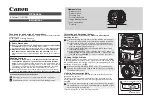
AXIS M3204-V Network Camera
Video
Click
Save
to apply the new settings.
H.264
H.264, also known as MPEG-4 Part 10/AVC, is a video compression standard that provides high quality video streams at low bit rates.
An H.264 video stream consists of different types of frames such as I-frames and P-frames. An I-frame is a complete image whereas
P-frames only contain the differences from previous frames.
The
GOV length
is the number of frames between two consecutive I-frames. Increasing the GOV length may save considerably on
bandwidth requirements in some cases, but may also have an adverse affect on image quality.
The bit rate can be set as
Variable bit rate
(VBR) or
Constant bit rate
(CBR). VBR adjusts the bit rate according to the image
complexity, using up more bandwidth for increased activity in the image, and less for lower image activity. When the activity in
the scene increases, the bit rate would usually increase as well. If there is a surplus in bandwidth, this may not be an issue and
selecting
Variable bit rate
(VBR) will be sufficient. But if bandwidth is limited, it is recommended to control the bit rate by selecting
Constant bit rate
(CBR). When the activity in the scene increases, VBR adjusts the bit rate according to the complexity, using up
more bandwidth for increased activity in the scene, and less for lower scene activity. CBR allows you to set a target bit rate that
limits the bandwidth consumption.
The CBR target bit rate works like the ceiling of a tent. It limits the bit rate, while maintaining some flexibility. The bit rate may bounce
up and down within the set target but when it nears the set target value, the limitation kicks in. However, because CBR will always
prioritize a continuous video stream, it allows temporary overshoots from the target bit rate. Because setting a target value prevents
the bit rate from increasing, frame rate and image quality are affected negatively. To partly compensate for this, select which variable
shall be prioritized, frame rate or image quality. Not setting a priority means that frame rate and image quality are equally affected.
The current bit rate can be set to appear as text overlay. Under
Overlay Settings
, select
Include text
and enter the modifier
#b
in the field.
To apply the settings, click
Save
.
MJPEG
Sometimes the image size is large due to low light or complex scenery. Adjusting the maximum frame size helps to control the
bandwidth and storage used by the Motion JPEG video stream in these situations. Setting the frame size to the
Default
setting
provides consistently good image quality at the expense of increased bandwidth and storage usage in low light. Limiting the frame
size optimizes bandwidth and storage usage, but may give poor image quality. To prevent increased bandwidth and storage usage,
the maximum frame size should be set to an optimal value.
Stream Profiles
A stream profile is a set of predefined stream settings including resolution, compression, frame rate and overlay settings. Stream
profiles can be used:
•
When setting up recording using action rules. See
•
When setting up continuous recording. See
Continuous Recording on page 34
•
In the Live View page – select the stream profile from the
Stream profile
drop-down list.
For quick setup, use one of the predefined stream profiles. Each predefined profile has a descriptive name, indicating its purpose. If
required, the predefined stream profiles can be modified and new customized stream profiles can be created.
To create a new profile or modify an existing profile, go to
Setup > Video
>
Stream Profiles
.
To select a default stream profile for the Live View page, go to
Setup > Live View Config
.
Camera Settings
The
Video > Camera Settings
page provides access to advanced image settings for the Axis product.
16
















































